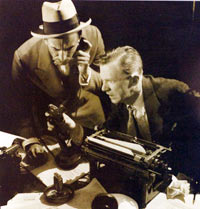COMMENT: Jumping the gunman
By Stephen Engelberg. Published in ProPublica.
The recent reporting on Maj. Nidal Malik Hasan, who is accused of killing 13 people at Fort Hood, is a classic run-and-gun investigative story in which dozens of reporters badger officials to disclose a new fact (which gets you on page one) or two new facts (which is enough to snag the coveted lead-of-the-paper slot on a slow day). This wolf-pack approach to reporting almost invariably produces stories that lack context, which is hardly surprising.
After all, reporters are telling a complex story by unveiling the key aspects as they learn them. It’s roughly akin to taking scenes from say, the three “Godfather movies” and spitting out them out as YouTube videos in random order. Good luck to anyone trying to follow the plot.
On the Hasan story, one of the earliest newsbreaks seems, at least so far, to be among the least clear.
About a year ago, U.S. intelligence intercepted messages [2] sent by Hasan to Anwar al-Awlaki, a radical imam in Yemen. A task force of counterterrorism officials reviewed those messages [3], determined they were benign —consistent with work-related research Hasan was doing — and never contacted anyone in the military familiar with Hasan’s record in the military.
Newspapers [4], Web sites [5] and TV [2] all gave huge play [6] to the story. But what was anyone expecting the government to do about someone who exchanged e-mails or text messages with a known bad guy? Seize his legally obtained gun? Remove him from his job? Arrest him as a material witness to a crime not yet committed?
Last night, NPR provided some context [7] in an exclusive story on “All Things Considered.” Daniel Zwerdling reported that Hasan’s supervisors at Walter Reed Army Medical Center had become increasingly worried that their young resident was losing touch with reality and might be psychotic and a danger to himself or others. They weighed firing Hasan, decided that would be too difficult, and sent him off to Fort Hood without a formal mental health evaluation.
Now, the intercepted messages story has more meaning.
Remember the contacts between Hasan and the Yemeni cleric? They are reported to have occurred in December 2008, which appears to be the same time as Walter Reed doctors were wondering whether Hasan might be capable of what NPR termed “fratricide.”
The terrorism task force that reviewed the potential threat posed by Hasan looked at his personnel files. But they never knew of the doctors’ concerns, because as, The New York Times reported [8] today, the doctors didn’t add them to his file.
Had the Federal Bureau of Investigation spoken to his supervisors – an idea that raises a host of civil liberties and privacy questions – the assessment of the danger he posed might have been different. But the available facts suggest that no one knew the full picture, which meant no one could start “connecting the dots.’’
The reader faces a similar challenge as the Hasan story unfolds in the coming months.
Here’s something to keep in mind: It is a long-established rule for reporting that the first accounts of any military action are frequently wrong. A corollary: The initial reports in a run-and-gun investigative story seldom age well. Remember the hero female cop who shot Hasan? Well, maybe she did and maybe she didn’t [9]. And the purported view of Walter Reed officials that Hasan might be a threat? Shortly after the NPR story aired, the Washington Post asserted [10] the possibility that Hasan might be “delusional” was never taken seriously and addressed by his supervisors only “in passing.’’
Stay tuned.


























